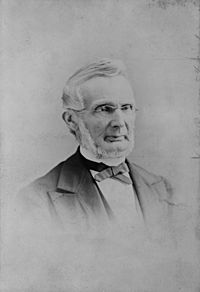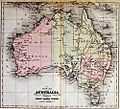Arnold Henry Guyot facts for kids
Quick facts for kids
Arnold Henry Guyot
|
|
|---|---|

Arnold Henry Guyot
|
|
| Born | September 28, 1807 Boudevilliers, Canton of Neuchâtel, Switzerland
|
| Died | February 8, 1884 (aged 76) Princeton, New Jersey, United States
|
| Nationality | Swiss |
| Citizenship | American |
| Scientific career | |
| Fields | geology geography |
| Influences | Louis Agassiz |
Arnold Henry Guyot (pronounced GEE-oh) was a famous Swiss-American scientist. He was born on September 28, 1807, and passed away on February 8, 1884.
Arnold Guyot was a geologist, who studies the Earth's rocks and history, and a geographer, who studies the Earth's features and how people live on it. A special type of underwater mountain, called a guyot, was named after him!
Contents
Arnold Guyot's Early Life
Arnold Guyot was born in a place called Boudevilliers, near Neuchâtel, in Switzerland. This was on September 28, 1807.
He went to college in Neuchâtel and Chaux-de-Fonds. In 1825, he traveled to Germany. There, he met another famous scientist, Louis Agassiz.
Guyot continued his studies in Stuttgart and then returned to Neuchâtel in 1827. He planned to become a minister, so he went to the University of Berlin.
While studying, he also took classes in philosophy and natural science. In his free time, he loved collecting shells and plants. He even got special permission to visit the Berlin Botanical Garden from a very important scientist, Alexander von Humboldt. In 1835, he earned his PhD degree from Berlin.
His Amazing Discoveries and Work
In 1838, his friend Louis Agassiz suggested that Guyot visit the Swiss glaciers. Glaciers are huge, slow-moving rivers of ice.
Guyot spent six weeks studying these glaciers. He shared his findings with the Geological Society of France. He was the first to notice important things about how glaciers move and what they are made of.
He observed that the center of a glacier moves faster than its sides. Also, the top of a glacier moves faster than its bottom. He described the layered look of glacial ice. Guyot believed glaciers moved because tiny parts of the ice slowly shifted. Before him, many thought glaciers just slid along. He also collected important information about large rocks called "erratic boulders." These boulders are found far from where they originally formed, carried by glaciers.
In 1839, Guyot became a professor at the College of Neuchâtel. He taught history and physical geography there, working with Agassiz.
When the college closed in 1848, Guyot moved to the United States. He settled in Cambridge, Massachusetts. He gave a series of lectures that were later published as a book called Earth and Man (1849).
For several years, he worked for the Massachusetts Board of Education. He taught teachers about geography and good teaching methods.
In 1854, Guyot became a professor at Princeton University. He taught physical geography and geology there until he passed away. He also taught at other schools, including the State Normal School in Trenton, New Jersey.
Guyot helped start the museum at Princeton University. Many of the rocks and specimens in the museum were from his own collections.
In the United States, Guyot also worked on improving how we observe the weather. Much of this work was done with the Smithsonian Institution. His detailed weather observations helped create the United States Weather Bureau. His book, Meteorological and Physical Tables (first published in 1852), was used for a long time.
Arnold Guyot was a deeply religious person. He believed that science and faith could go together. He thought the Earth was very old, and that the "days" in the Bible's creation story could represent much longer periods of time. Scientist James Dwight Dana said Guyot was "a fervently religious man, living as if ever in communion with his Heavenly Parent; a Christian, following closely in the footsteps of his Master."
Related pages
Images for kids
See also
 In Spanish: Arnold Henry Guyot para niños
In Spanish: Arnold Henry Guyot para niños


